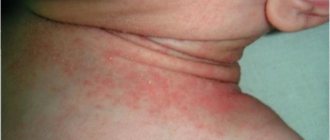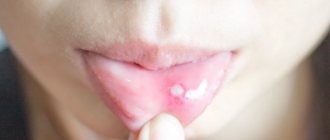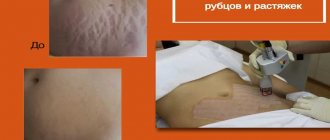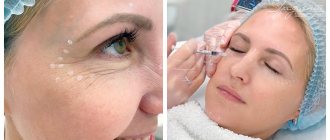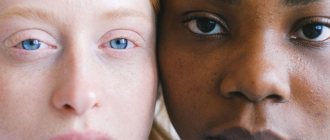Allergy on the face in the form of red spots is a common problem with which patients often turn to dermatologists. To clarify the exact cause of this condition most often requires time and a number of additional studies. To alleviate the condition of allergic dermatitis, modern antiallergic drugs are used, which include Cetrin.
Symptoms
It is quite easy to suspect an allergic reaction in yourself or your child. In addition to the presence of an allergic rash on the face, the following complaints are noted:
- Severe itching or burning;
- Dryness, flaking of the skin;
- Swelling of the eyelids, lips;
- lacrimation;
- Itching and redness of the eyes.
The rash itself may be in the form of red spots or blisters filled with transparent contents. Sometimes an allergic rash looks like small grouped dots that rise above the surface of the skin. If the rash appears after consuming any product, then symptoms may include nausea, vomiting, diarrhea, and abdominal pain1.
Color of the skin
Look to see if any changes have appeared on your face, such as swelling or hyperpigmentation. Skin color is very important in assessing health.
Straw color.
If you have a straw complexion, you need to do a biochemical blood test. The symptom often signals a vitamin B12 deficiency.
B12 deficiency is obvious if a set of symptoms is present:
- lips have a straw tint;
- epigastric pain occurs;
- there is a burning sensation of the tongue;
- depression is present.
B12 deficiency can be expressed not only by a discolored complexion, but also by other symptoms.
Gray complexion.
A grayish tint to the face appears in people with chronic lung disease and in smokers. However, in the latter, chronic lung pathology occurs most often.
Smokers should regularly undergo spirometry testing to diagnose the disease. And if your skin color has taken on a gray tint, you need to get checked immediately.
Paleness of the skin.
Pale facial skin indicates anemia or low blood pressure. The condition is especially noticeable with temporary drops in pressure.
Redness.
If the face turns red, this may indicate pressure surges. When it comes to experiencing strong emotions, the problem is temporary and does not pose a danger.
With constant redness of the face with simultaneous redness of the conjunctiva, a comprehensive diagnosis is required, including a set of specialized cardiological studies. Such symptoms are caused by vascular diseases and heart problems.
But redness in the form of symmetrical spots on the nose and cheeks, resembling the shape of a butterfly, is one of the initial manifestations of lupus, one of the most dangerous and formidable kidney diseases.
Hyperpigmentation spots
. If the spots are brown and appear randomly, mainly on the forehead and cheeks, these are rather symptoms of impaired liver function. A blood test should be done for so-called liver tests.
In this case, it is recommended to exclude from the diet:
- coffee and alcohol;
- fats;
- spicy spices;
- foods with saturated and trans fats.
If the spots are symmetrical and appear on the upper lip, then the condition often indicates hormonal disorders.
Causes
The main reasons for the appearance of red spots on the skin of the face:
- Direct skin contact with an allergen (cream, face mask, decorative cosmetics, soap, jewelry, etc.);
- Food allergies;
- Allergy to medications;
- Allergy to sun or cold;
- Eczema1.
To prevent the appearance of a rash in the future, it is necessary to accurately determine the cause of the allergy and eliminate contact with this substance.
What to do with local redness
Treatment of vascular pathologies and infectious diseases should be carried out under the supervision of a specialist on an outpatient basis. If the doctor determines that there are no medical problems, you can try to eliminate the defect yourself. Beauty salons offer several options for treating redness on the skin. Among the most effective:
- cryodestruction;
- ozone therapy;
- electrocoagulation;
- laser exposure;
- diathermocoagulation.
At home, whitening masks, lotions and compresses are effective.
The choice of method depends on the cause of the stains. Electrocoagulation and diathermocoagulation will help remove the effects of rosacea. The affected areas of the vessels are removed with an electrical impulse or a hair electrode. Cryodestruction allows you to quickly and painlessly get rid of angiomas. Sclerosing therapy can also help remove vascular tumors. Adhesive substances are injected into damaged vessels to promote the growth of collagen fibers. Red acne is treated with mechanical or chemical peels, as well as laser resurfacing.
Mechanical resurfacing will help deal with red spots on the skin.
Contact dermatitis
Contact dermatitis rashes are most often localized on the hands or face. An allergic reaction can be triggered by:
- Skin care products. It is important to pre-test creams, masks, lotions and other new products by applying a small amount of product to the inner surface of the forearm for 15-20 minutes.
- Decorative cosmetics. Contains a large number of coloring pigments, fragrances and preservatives. People with sensitive skin prone to dryness and irritation are more prone to allergic reactions.
- Plant pollen. When pollen from plants to which a person is allergic comes into contact with the skin, a rash, itching and other unpleasant symptoms may appear.
Red spots may appear either immediately after contact with the allergen or after some time (usually within 24-48 hours). If you find the cause of the allergy in time and stop using the inappropriate product, then no negative health consequences will be noted.
Facial swelling
A slight swelling of the facial tissues, which persists constantly, most often indicates the initial stage of an endocrine disease - hypothyroidism. Pigmentation quickly disappears after taking thyroid hormone - thyroxine.
Mild and persistent swelling of the face, which is accompanied by shortness of breath and swelling of the legs, usually in the ankles, as well as frequent getting up at night to go to the toilet, indicates circulatory failure and poor heart function.
When swelling of the face is accompanied by pallor, and visits to the toilet are very frequent, but urination is scanty, kidney disease can be suspected.
It is very dangerous when fluid accumulates only in the upper lip. If the swelling is accompanied by a feeling of tightness in the chest, difficulty breathing, then this is an allergic reaction - Quincke's edema!
The condition can become a serious threat to life. In this case, an ambulance is needed.
Allergies to foods and medications
Food allergies on the face are quite common, especially in children. The most allergenic foods are peanuts, eggs, seafood, citrus fruits, and dairy products. However, in the presence of individual intolerance, an allergy can develop to any other food product.
Main symptoms:
- blotchy rash on the face or body;
- Severe itching;
- Peeling of the skin;
- Nausea, vomiting;
- Stool disorders;
- Abdominal pain.
Another important problem is drug allergies. An allergic reaction may occur to a medicine in the form of a tablet, injection, or ointment. Allergies to antibiotics, antiseptics, and nonsteroidal anti-inflammatory drugs are common. The symptoms are the same as those of a food allergy. In severe cases, complications such as angioedema or anaphylactic shock may develop2. You need to know what drugs you are allergic to and warn doctors or medical staff about it.
Removal of spider veins and visible vessels on the face. (Photocoagulation, photorejuvenation)
Spider veins on the cheeks, nose, red cheeks, purple face - all this is characteristic of the disease rosacea, its first manifestations are often called rosacea. This is a constitutional feature, it does not affect our well-being in any way, but it is of great importance in the perception of the people around us.
There are many options for camouflage, prevention, lifestyle rules, skincare cosmetics that slow down the process, but few techniques can remove dilated blood vessels that have already appeared on the face.
One of the most effective is a hardware procedure using IPL systems, also called photocoagulation or photorejuvenation. This can be done by a cosmetologist in his office. The processing area depends on the area of the process. Of course, what you won’t leave the consultation without is the wise advice of a cosmetologist
CLICK on one photo to view the entire photo gallery
Allergy to sun or cold
Natural factors can also cause the development of allergic reactions. Photoallergy or sun allergy most often occurs in the warm season - from late spring to early autumn. Sometimes an allergic rash is confused with sunburn, but the allergic nature of the disease is characterized by severe itching, the appearance of small, white pustules, and spotty red rashes even after a short stay in the open sun. In such cases, you need to apply sunscreen, protect exposed skin with clothing made from natural fabrics, and wear a hat3.
Allergy to cold or cold urticaria also occurs. During the cold season, red itchy rashes, peeling, and a feeling of tightness appear on the skin of the face and hands. Symptoms may persist for several hours or several days after exposure to the cold. Typically, allergies develop at temperatures from 10 degrees below zero, but it also happens at temperatures close to zero.
Causes of red moles on the body
By its nature, a red mole is a cluster of vessels and capillaries, which normally perform the function of oxygen and nutritional supply to the epidermal structures. With the development of any internal pathological process or under the influence of exogenous factors, small vessels can connect, forming a kind of bundle, which in medicine is often called an angioma.
When asked by a patient regarding small red moles, “What is this?”, the specialist will most often answer – angioma. Typically, these pigmented formations are formed during the period of active growth of the body, that is, in early childhood, which is associated with a serious transformation of the human vascular system at this age.
A distinctive feature of red pigmented nevi is the loss of color intensity of the formation when pressing on it, which is associated with a vascular reaction. In addition, red moles normally do not hurt or itch, and do not change their shape and size over time.
The following etiotropic factors may be the causes of angiomas in adult patients:
- Excessive sun exposure (excessive ultraviolet radiation);
- Hormonal imbalance (puberty, pregnancy, menopause, etc.);
- Pathologies of the gastrointestinal tract, especially the pancreas;
- Injuries and mechanical damage to the epidermal integument;
- Diseases of the cardiovascular system;
- Violation of the formation or destruction of pigmented cells.
Today, doctors do not give a clear answer regarding the causes of red moles on the body, however, the factors listed above can become a provoking condition for their appearance.
Eczema
Eczema is an inflammatory skin disease that tends to be chronic and relapsing. Often the symptoms of eczema are confused with allergic reactions, since the rashes can be similar in appearance. Eczema is characterized by the appearance of bright red spots and swelling of the skin. Grouped bubbles with transparent contents appear on a red background, after which crusts form.
The occurrence of the disease is associated with mechanical damage to the skin, microbial or fungal infection, and occupational hazards. Complex immune reactions characteristic of allergies also take part in the development of pathology.
Types of red moles
The appearance of red moles on the body can be accompanied by various visual characteristics of the defect. Such epidermal formations can be either flat, forming in the deep dermal layers, or have a superficial nature, protruding above the skin. Moreover, according to the nature of the visual picture, all angiomas are usually divided into two groups:
- Spot. The pigmented area has clear red borders and is a point at which a collection of vessels and capillaries is concentrated. Often, punctate angiomas are multiple in nature, manifesting themselves in the form of specific “rashes” on the patient’s skin.
- Star-shaped. Such moles are a collection of tiny thin vessels that are visible through the epidermis and converge at a central point, forming a kind of star. These structures are also associated with diseases such as rosacea.
In addition, a separate group includes especially large red moles on the body - hemangiomas, which usually significantly spoil the patient’s appearance and require cosmetic correction.
Treatment
Treatment for facial allergies must include a safe and effective antihistamine3. Cetrin is widely used for seasonal allergies and various forms of allergic dermatitis. The main active ingredient of the drug is cetirizine hydrochloride, which is a histamine antagonist. The advantages of the drug include:
- Quick effect. Onset of action 20 minutes after administration.
- Duration of action. The drug is taken once a day and is effective for 24 hours.
- Good tolerance. Cetrin is well tolerated by patients and causes less drowsiness than first-generation drugs1.
The drug helps eliminate itching, swelling, and redness of the skin. Available in tablet form, approved for use in children over 6 years of age. If you suspect an allergic rash, taking Cetrin is a simple, safe way to make you feel better before you can see a doctor.
Vessels on the face, redness and swelling. Before and after
The procedure is not very pleasant, but tolerable, and most importantly, quite fast. Rehabilitation takes an average of 24 hours; in rare cases, there may be redness and swelling for up to 3-5 days. Therefore, if you have not undergone a similar procedure before, it is better to schedule it before a couple of days off. Usually 3-4 procedures are required with an interval of 3-5 weeks, the effect is often visible after 1-2 procedures.
